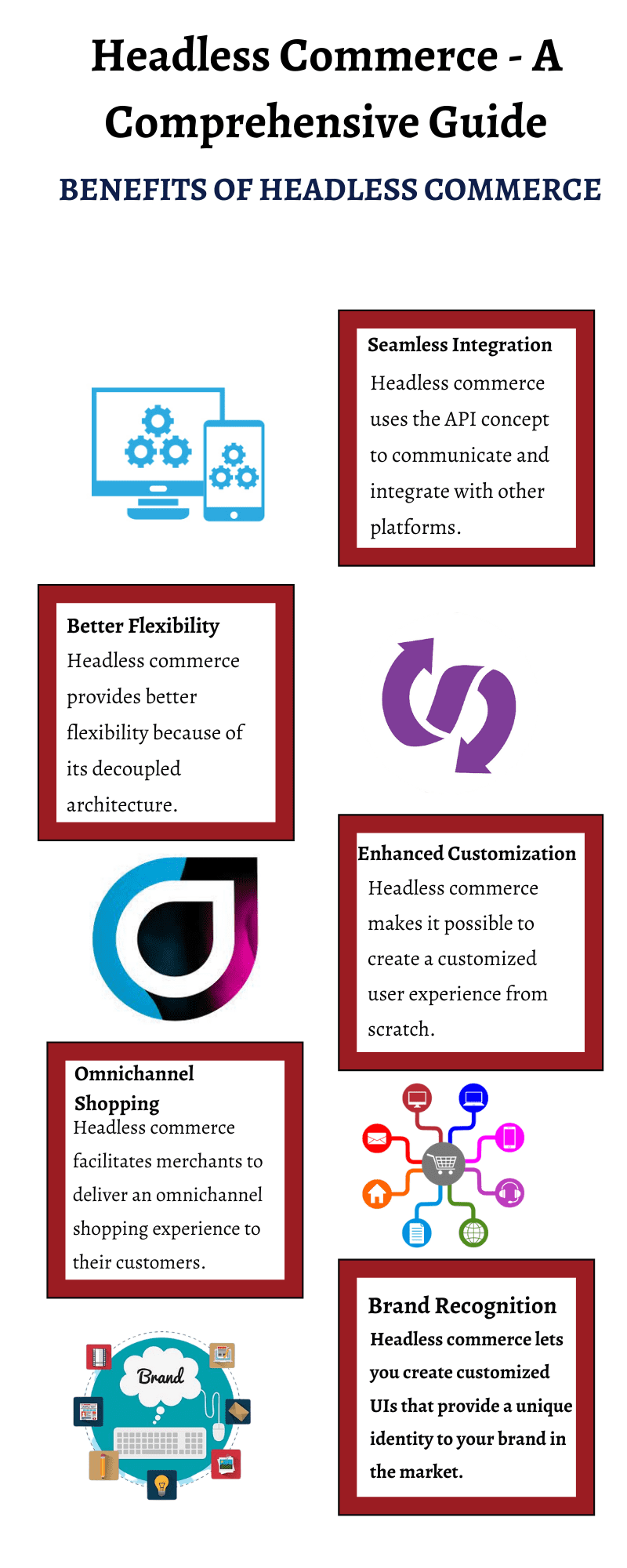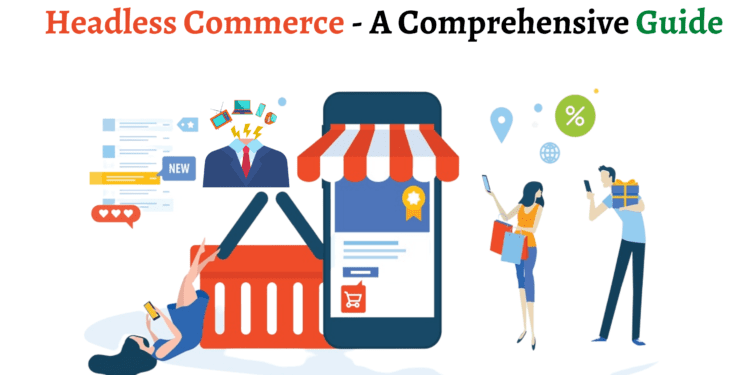The world of eCommerce is changing day by day. The evolution of eCommerce-based businesses has created a highly competitive, consumer-focused environment amongst online retailers.
Headless commerce is an emerging technology freeing the front-end from the back-end. It makes it effortless to connect all the touchpoints via APIs.
Keep reading this guide to understand the concept of headless commerce, its architecture, benefits, drawbacks, how it is different from traditional commerce, and some of the headless commerce platforms. Let’s start with the topic.
What is a Headless Commerce?
Headless commerce refers to separating the front-end layers of a platform from its back-end layers.
Headless commerce facilitates developers to integrate with any platform via API. If we talk about APIs, it is a set of protocols and definitions that enables two components to communicate. They can use the APIs to deliver things such as customer reviews and blog posts to any screen or device.
Headless commerce stores manage and deliver content without using the front-end layer, i.e., your site’s UI. By hiring a competent Headless commerce company, you can create winning commerce experiences in marketplaces.
The Architecture of Headless Commerce
Headless commerce has a decoupled architecture designed for delivering content via APIs. In traditional commerce, the front-end is connected to the back-end, including the server’s information and data structure. This results in traditional commerce that can work on a device that supports its front-end framework.
A headless commerce system works by sharing requests between application layers and presentation layers through web services or API. The presentation layer is connected with eCommerce functionality through APIs that define interactions between various software intermediaries. It lets businesses modify customer-facing experiences without disturbing back-end functionality and use APIs for updating, editing, or changing products to multiple front-ends.
Comparison between Headless Commerce and Traditional Commerce
Now, let’s understand the comparison between traditional commerce and headless commerce.
Headless commerce is different from traditional commerce, as traditional commerce works on a monolithic (composed all in one piece) architecture, whereas headless commerce works on decoupled architecture.
A monolithic application describes a single-tiered software application in which different components, such as the presentation layer, database layer, authorization, etc., are combined into a single program.
Let’s differentiate both headless commerce and traditional commerce on the basis of some characteristics –
Flexible Front-End Development
- In traditional commerce, front-end developers need to navigate constraints and obstacles in the development process.
- Whereas in headless commerce, front-end developers can make a user experience separately as per the business requirements and objectives.
Adaptability
- In traditional commerce, personalizing the user experience requires revamping the front end. Moreover, adapting to changes in user experience with traditional commerce is also a challenging task.
- On the other hand, headless commerce is less challenging for developers to create customized user experiences.
Customization
- In traditional commerce, the front-end is coupled tightly with back-end coding. So, for little customization, developers have to update various coding layers.
- In contrast, headless commerce has a decoupled architecture that separates the front end and back end. It creates endless customization possibilities.
Now, let’s move toward the benefits and limitations of using headless commerce.

Advantages of Headless Commerce
It is beneficial for brands to switch to headless commerce, and the reasons for the same are discussed as follows –
-
Seamless Integration
Headless commerce uses an API that makes it easier to communicate and integrate with other platforms. It helps you add your brand to any new device that expands opportunities and outreach to many customers simultaneously. Moreover, with headless commerce, integrating into new devices can be performed in some hours instead of months.
-
Better Flexibility
As mentioned above, a decoupled headless commerce architecture separates the front end and back end, making it possible to update the presentation layer without disrupting the back end. It facilitates merchants to offer numerous front-end interface options from traditional devices to the latest smart technologies.
-
Faster Scaling
Headless commerce makes it possible to scale up the website and its capabilities whenever required. This is because, using headless commerce, it is possible to rapidly change the front end or integrate additional features for the products without affecting the website’s performance.
-
Enhanced Customization
It is possible to create a customized user experience from scratch with headless commerce. It removes the design and customization issues found in traditional eCommerce platforms. It enhances the customization by allowing businesses to build and experiment with varied user interfaces (UIs).
-
Seamless Omnichannel Shopping
Customers seek a seamless shopping experience between various channels. Headless commerce solves this challenge for eCommerce stores by introducing unmatched flexibility and customization while delivering an omnichannel shopping experience to their customers.
-
To Remain Competitive
Without impacting the back end, Headless commerce allows for faster updates. As consumer technology adapts, it is possible to adjust the front end as per the requirements. Conversely, in traditional commerce, an update impacts the entire system as the front end, and back end are inextricably connected.
-
Brand Recognition
Traditional eCommerce platforms, generally brands, rely on the existing templates. Other than some graphics and colors, they look the same, but if you try to design a specific template, you will have to work within the existing designs of vendors.
Conversely, headless commerce gives you the control on the front end to create customized UIs that make a unique identity of your brand in the market. So, for an appealing front end in headless commerce, you can make your own design principles that nurture your brand recognition and enhance conversion rates.
So, if you are fed up with traditional commerce platforms and want to migrate your existing eCommerce store to a headless solution, you can prefer an organization offering headless development services for a successful headless eCommerce store.
Disadvantages of Headless Commerce
Here is the time to see another face of the coin: the limitations of headless commerce. Let’s see some of the drawbacks of using headless commerce.
-
Additional Costs
Though we have considered the word decoupled architecture of Headless commerce as a benefit, it is also a limitation. It can cause an increase in the total cost to operate your website. This is because creating a separate front end and back end needs their own hosting and maintenance.
-
Requires Continual Oversight
Headless commerce includes more mixing and matching. So, based on the complexity, you require a more headless development team that oversees the various parts of the headless architecture. As a result, it may not be a good choice or practical solution for smaller businesses.
-
Relatively High Maintenance
It is hard to maintain headless commerce as you have to specifically handle the front-end, back-end, and various APIs. So, you require a large team for maintaining the setup of headless commerce.
Headless Commerce Platforms
-
Big Commerce
It is an API-first and flexible eCommerce platform that helps merchants grow their sales across every growth stage. It lets you create headless eCommerce platforms to deliver flexible and highly customizable store fonts.
Big Commerce is equipped with sophisticated and robust APIs that can be connected to any environment.
-
Shopify Plus
Shopify Plus makes transitioning to headless architecture smooth and easy. It is an extensive platform that provides various headless commerce options. It provides integrations that improve the user experience. For mid-to-large-sized brands, Shopify Plus can be a good headless eCommerce option. It provides businesses the ability to customize the user experience and store performance.
-
Elastic Path
It is a headless commerce system that allows template class eCommerce to be integrated as middleware into enterprise ERP systems. Elastic path is an API-based platform that particularly targets enterprise-level organizations.
Conclusion
Now, you have a better understanding of headless commerce. The best thing about Headless commerce is that it brings together solutions independent of each other but possible to merge easily. It has now started being adopted by major eCommerce brands.
So, by selecting headless commerce for your business, you will have the flexibility to create a specific platform for your visitors. Apart from that, you should be aware of your business standards and requisites while considering headless commerce for your business.










